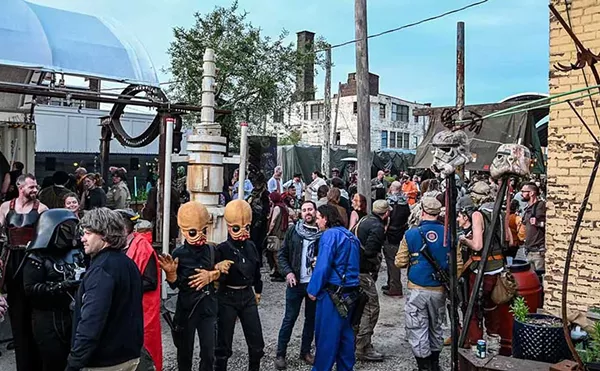
Audio By Carbonatix
[
{
"name": "GPT - Leaderboard - Inline - Content",
"component": "35519556",
"insertPoint": "5th",
"startingPoint": "3",
"requiredCountToDisplay": "3",
"maxInsertions": 100,
"adList": [
{
"adPreset": "LeaderboardInline"
}
]
}
]
Mick Jagger looks his age close-up. That immortal mouth with its Italian Renaissance lips is framed by a face that looks dispassionately rendered by Lucian Freud's unforgiving brush.
His voice is older, too, at times flat. Of course, Jagger isn't the only man looking every bit his age at the November 2006 Rolling Stones' show captured by Martin Scorsese in Shine a Light. No, at New York's 3100-seat Beacon Theater, Ronnie Wood and Charlie Watts show faces that'd make swell sides of old coins. And Keith Richards? Well ...
When the camera pulls back to show Jagger as a perpetual-motion bandleader, though, you marvel at how well he moves. He's onstage to give his audience the Rolling Stones experience. Whether strut-dashing down one of the outstretched piers or wiggling and throwing his arms about in that part-snake, part-flamingo thing he's been doing since the '70s, Jagger knows how to exaggerate moves to reach back to the cheap seats. Doesn't matter that the Beacon's size is but a fraction of the countless stadiums the Stones have played in their 46-year career; it takes a special man to bring spirit fingers and jazz hands into rock 'n' roll.
Even so, the Stones of Light are obviously not the cavalier cultural juggernauts seen in Jean-Luc Godard's 1968 Sympathy for the Devil and Albert and David Maysles' 1970 Gimme Shelter, or the frequently bored decadents of Robert Frank's 1972 Cocksucker Blues. The Stones on this night are halfway through the two-year-long "A Bigger Bang" tour, the highest-grossing tour in history, pulling in more than $500 million. And just what kind of band makes more than the 2007 gross domestic product of the entire country of Samoa?
That's what so bewildering about this document: Shine is a vanity project from a band and filmmaker who have nothing left to prove and little to be vain about. It's a warts-and-all peek at this particular performance — a charity benefit for Bill Clinton's 60th birthday. It's a look at Scorsese — who used 12 Stones songs in four of his films, "Gimme Shelter" in three — trying to micromanage a concert the way he might a film set. In the process, both band and filmmaker are shown readily admitting that what they're doing is creating more Stones product. What's not surprising is Scorsese and band emerge looking well — but not because Light is purely a puff piece.
Oh, it's wantonly fawning, to be sure. After an opening that captures Scorsese attempting to nail down set lists so he can orchestrate a mammoth camera crew headed by cinematographer Robert Richardson, Light settles into a basic concert doc. Archival footage is inserted, from very early in the band's career on through its 1970s heyday — when they all looked much better. The clips remind you that the Stones, unlike many of their peers, are still around and still doing it for their fans — even if they can't always pull it off. They remind us that the band has lived the absurd Stones life for an awfully long time. And clips with British, European and Japanese reporters show that they've been asked the same dumb questions forever — If you weren't Mick Jagger, who would you be? — and that they've always tried to handle it with humor and grace.
The film-show includes 18 songs, from the so-so ("Shattered" and opener "Jumpin' Jack Flash") to the rough ("She Was Hot") to the disarmingly sincere ("As Tears Go By," the live fave "Tumbling Dice") and the damned near sublime (Jack White joins Jagger for "Loving Cup," and Buddy Guy appears on Muddy Waters' "Champagne and Reefer" to remind everybody, again, that the Stones have always been the white man's blues).
There's a matter-of-fact aspect that makes Light more than just another doc for die-hard fans. The rock spoils go to the survivors, but so do age and constantly having to be the Rolling Stones. So when the band finally sings for its supper — with those required set-list fillers "Sympathy (For the Devil)," "Start Me Up," and "(I Can't Get No) Satisfaction" — you're reminded of the pre-show meet with Clinton, his family, the president of Poland, and the 30 other guests for whom the band has to smile and make nice. Forty-three years after their first American No. 1 single, nobody expects the Rolling Stones to write songs up to the same snuff of their glory days. But, you've got to give credit where it's due.
Bret McCabe is the arts editor of our sister paper, Baltimore’s City Paper. Send comments to letters@metrotimes.com.





